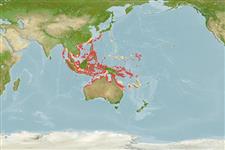>
Ovalentaria/misc (Various families in series Ovalentaria) >
Pomacentridae (Damselfishes) > Pomacentrinae
Etymology: Neoglyphidodon: Greek, para = the side of + Greek, glyphis = carved + Greek, odous = teeth.
More on author: Cuvier.
Environment: milieu / climate zone / depth range / distribution range
Ökologie
seewasser riff-verbunden; standorttreu; tiefenbereich 2 - 23 m (Ref. 7247). Tropical; 32°N - 25°S, 92°E - 171°E
Indo-West Pacific: Andaman Sea (Phuket), Malayan Archipelago, Indonesia, Philippines, Taiwan, Ryukyu Islands, Palau, New Guinea, Solomon Islands, Vanuatu, and northern Australia. Previously referred to as Paraglyphidodon behnii by Allen (see Ref. 4966).
Size / Gewicht / Alter
Maturity: Lm ? range ? - ? cm
Max length : 13.0 cm TL Männchen/unbestimmt; (Ref. 48636)
Rückenflossenstacheln (insgesamt) : 13; Rückenflossenweichstrahlen (insgesamt) : 14 - 16; Afterflossenstacheln: 2; Afterflossenweichstrahlen: 13 - 15.
Two forms: long-tailed and black as adults occur in the Andaman Sea, ranging east to western Bali and north to Japan. Second form, probably valid as N. xanthurus occur in the rest of the West Pacific and the two overlap in range on Bali's north coast (Ref. 48636). Occur in coral-rich areas of lagoon and seaward reefs. Usually solitary (Ref. 1602). Feed on algae, crustaceans, and pelagic tunicates and salps. Oviparous, distinct pairing during breeding (Ref. 205). Eggs are demersal and adhere to the substrate (Ref. 205). Males guard and aerate the eggs (Ref. 205). Diurnal species (Ref. 54980; 113699).
Life cycle and mating behavior
Geschlechtsreife | Fortpflanzung | Ablaichen | Eier | Fecundity | Larven
Oviparous, distinct pairing during breeding (Ref. 205). Eggs are demersal and adhere to the substrate (Ref. 205). Males guard and aerate the eggs (Ref. 205).
Allen, G.R., 1991. Damselfishes of the world. Mergus Publishers, Melle, Germany. 271 p. (Ref. 7247)
IUCN Rote Liste Status (Ref. 130435: Version 2024-1)
Bedrohung für Menschen
Harmless
Nutzung durch Menschen
Fischereien: kommerziell; Aquarium: Öffentliche Aquarien
Tools
Can't connect to MySQL database fbquizv2. Errorcode: Too many connections
